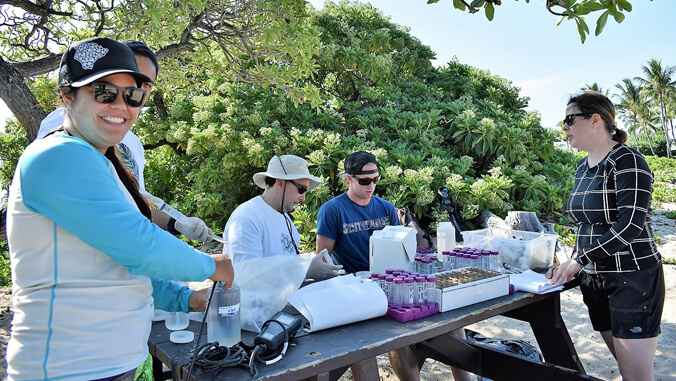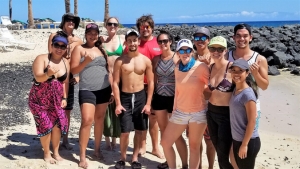
Distribution of nutrient pollution in coastal waters and coastal reefs in proximity to Hawaiʻi Island developments has been documented by a group of University of Hawaiʻi at Hilo researchers, students and community partners. Their recently published findings, including the sources of pollution, are imperative to improving overall water quality on the island.
“We had some people swimming out to collect water samples, and another team on the shoreline processing the samples,” said Tracy Wiegner, a marine science professor at UH Hilo who co-authored the study. “It was really great to see.”
The team discovered the overabundance of troublesome nutrients found in coastal waters and coral reefs are from human sources, such as fertilizer run off. According to researchers, coral reefs impacted by this type of nutrient pollution are less resilient to disease and ocean warming. They discovered the nutrient concentrations decreased as the team moved downhill toward the ocean. The findings were published in Marine Pollution Bulletin.
Pinpointing sources

The group sampled a variety of public beaches, the Waikoloa and Hualālai watersheds, and resort development areas, including Mauna Lani and Kūkiʻo, in order to identify distribution patterns and sources of excess nutrients found in groundwater, anchialine ponds (unique aquatic ecosystems where brackish water pools in the crevices and cracks of lava near shore), as well as ocean surface waters and water surrounding coral reefs.
At both Pauoa and Kūkiʻo, the researchers found higher concentrations of most nutrients in groundwater than in ocean water. Some anchialine ponds and shoreline seeps near landscaped areas, including golf courses, had elevated nutrient concentrations.
Wiegner and fellow UH Hilo Marine Science Professor Steve Colbert headed the research team and co-authored the study. Jazmine Panelo, a UH Hilo alumna, assisted with research and is the study’s lead author. Other co-authors include UH Hilo alumna Leilani Abaya and Courtney Couch of the Hawaiʻi Institute of Marine Biology and Cooperative Institute for Marine and Atmospheric Research at UH Mānoa.
Wiegner said it took a village to conduct the sampling. UH Hilo summer interns from the Pacific Internship Programs for Exploring Science collected data along with volunteer undergraduate and graduate students in the tropical conservation biology and environmental science program, and visiting students from out-of-state universities.
The research group worked closely with members of West Hawaiʻi communities who expressed interest in the collected data.
“[Our research partners] have close contact with these local communities and their community association leaders,” explained Wiegner. “We were able to learn from them which community associations were interested in the kinds of information we were collecting.”
For more go to UH Hilo Stories.
—By Jordan Hemmerly

